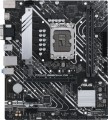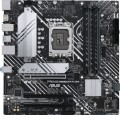Size (HxW)
Motherboard dimensions in height and width. It is assumed that the traditional placement of motherboards is vertical, so in this case one of the dimensions is called not the length, but the height.
Motherboard sizes are largely determined by their form factors (see above), however, the size of a particular motherboard may differ slightly from the standard adopted for this form factor. In addition, it is usually easier to clarify the dimensions according to the characteristics of a particular motherboard than to look for or remember general information on the form factor. Therefore, size data can be given even for models that fully comply with the standard.
The third dimension — thickness — is considered less important for a number of reasons, so it is often omitted.
DDR4
The number of slots for DDR4 memory sticks provided in the motherboard.
DDR4 is a further (after the third version) development of the DDR standard, released in 2014. Improvements compared to DDR3 are traditional — an increase in operating speed and a decrease in power consumption; The volume of one module can be from 2 to 128 GB. It is this RAM standard that most modern motherboards are designed for; the number of slots for DDR4 is usually
2 or
4, less often —
6 or more.
Max. memory
The maximum amount of RAM that can be installed on the motherboard.
When choosing according to this parameter, it is important to take into account the planned use of the PC and the real needs of the user. So, volumes
up to 32 GB inclusive are quite enough to solve any basic problems and run games comfortably, but without a significant reserve for an upgrade.
64 GB is the optimal option for many professional use cases, and for the most resource-intensive tasks like 3D rendering,
96 GB or even
128 GB of memory will not be a limit. The most “capacious” motherboards are compatible with volumes of
192 GB or
more - they are mainly top-end solutions for servers and HEDT (see “In the direction”).
You can choose this parameter with a reserve – taking into account a potential RAM upgrade, because installing additional RAM sticks is the simplest way to increase system performance. Taking this factor into account, many relatively simple motherboards support very significant amounts of RAM.
M.2 version
The version of the M.2 interface determines both the maximum data transfer rate and the supported devices that can be connected via physical M.2 connectors (see the corresponding paragraph).
The version of the M.2 interface in the specifications of motherboards is usually indicated by the number of connectors themselves and by the PCI-E revision provided for in each of them. For example, the entry “3x4.0” means three connectors capable of supporting PCI-E 4.0; and the designation “2x5.0, 1x4.0” means a trio of connectors, two of which support PCI-E 4.0, and another one supports PCI-E 5.0.
M.2 SSD cooling
Motherboard-integrated
cooling for M.2 SSD drives.
This connector allows you to achieve high speed, however, for the same reason, many M.2 SSDs have high heat dissipation, and additional cooling may be required to avoid overheating. Most often, the simplest radiator in the form of a metal plate is responsible for such cooling — in the case of an SSD, this is quite enough.
1x PCI-E slots
Number of PCI-E (PCI-Express) 1x slots installed on the motherboard. There are
motherboards for 1 PCI-E 1x slot,
2 PCI-E 1x slots,
3 PCI-E 1x ports and even more.
The PCI Express bus is used to connect various expansion cards — network and sound cards, video adapters, TV tuners and even SSD drives. The number in the name indicates the number of PCI-E lines (data transfer channels) supported by this slot; the more lines, the higher the throughput. Accordingly, PCI-E 1x is the basic, slowest version of this interface. The data transfer rate for such slots depends on the PCI-E version (see "PCI Express Support"): in particular, it is slightly less than 1 GB / s for version 3.0 and slightly less than 2 GB / s for 4.0.
Separately, we note that the general rule for PCI-E is as follows: the board must be connected to a slot with the same or more lines. Thus, only single-lane boards will be guaranteed to be compatible with PCI-E 1x.
PCI-E 16x slots
Number of PCI-E (PCI-Express) 16x slots installed on the motherboard.
The PCI Express bus is used to connect various expansion cards — network and sound cards, video adapters, TV tuners and even SSD drives. The number in the name indicates the number of PCI-E lines (data transfer channels) supported by this slot; the more lines, the higher the throughput. 16 lanes is the largest number found in modern PCI Express slots and cards (more is technically possible, but the connectors would be too bulky). Accordingly, these slots are the fastest: they have a data transfer rate of 16 GB / s for PCI-E 3.0 and 32 GB / s for version 4.0 (for more information about the versions, see "PCI Express Support").
Separately, we note that it is PCI-E 16x that is considered the optimal connector for connecting video cards. However, when choosing a motherboard with several such slots, it is worth considering the PCI-E modes supported by it (see below). In addition, we recall that the PCI Express interface allows you to connect boards with a smaller number of lines to connectors with numerous lines. Thus, PCI-E 16x will fit any PCI Express card.
It is also worth mentioning that in the design of modern "motherboards" there are slots of increased sizes — in particular, PCI-E 4x, corresponding in size to PCI-E 16x. However, the type of PCI-E slots in our catalog is indicated by the actual throughput; so only connectors that support 16x speed are considered as PCI-E 16x.
PCI Modes
Operating modes of PCI-E 16x slots supported by the motherboard.
For more information about this interface, see above, and information about the modes is indicated if there are several PCI-E 16x slots on the board. This data specifies at what speed these slots can operate when expansion cards are connected to them at the same time, how many lines each of them can use. The fact is that the total number of PCI-Express lanes on any motherboard is limited, and they are usually not enough for the simultaneous operation of all 16-channel slots at full capacity. Accordingly, when working simultaneously, the speed inevitably has to be limited: for example, recording 16x / 4x / 4x means that the motherboard has three 16-channel slots, but if three video cards are connected to them at once, then the second and third slots will be able to give speed only to PCI-E 4x level. Accordingly, for a different number of slots and the number of digits will be appropriate. There are also boards with several modes — for example, 16x/0x/4 and 8x/8x/4x (0x means that the slot becomes inoperable altogether).
You have to pay attention to this parameter mainly when installing several video cards at the same time: in some cases (for example, when using SLI technology), for correct operation of video adapters, they must be connected to slots at the same speed.
Steel PCI-E connectors
The presence of reinforced
steel PCI-E connectors on the "motherboard".
Such connectors are found mainly in gaming (see "In the direction") and other advanced varieties of motherboards, designed to use powerful graphics adapters. Steel slots are usually made PCI-E 16x, just designed for such video cards; in addition to the slot itself, its attachment to the board also has a reinforced design.
This feature offers two key advantages over traditional plastic connectors. Firstly, it allows you to install even large and heavy video cards as reliably as possible, without the risk of damaging the slot or board. Secondly, the metal connector plays the role of a protective screen and reduces the likelihood of interference; this is especially useful when using multiple video cards installed side by side.

